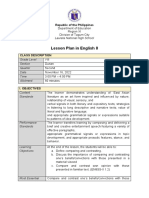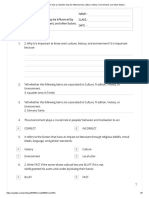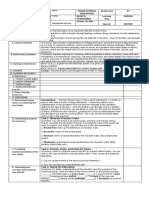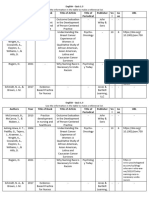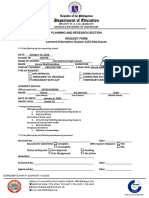SPFL DLL - Demo June 14
SPFL DLL - Demo June 14
Uploaded by
Chaii Madlangsakay TolentinoCopyright:
Available Formats
SPFL DLL - Demo June 14
SPFL DLL - Demo June 14
Uploaded by
Chaii Madlangsakay TolentinoOriginal Title
Copyright
Available Formats
Share this document
Did you find this document useful?
Is this content inappropriate?
Copyright:
Available Formats
SPFL DLL - Demo June 14
SPFL DLL - Demo June 14
Uploaded by
Chaii Madlangsakay TolentinoCopyright:
Available Formats
Republic of the Philippines
Department of Education
REGION IV- A CALABARZON
SCHOOLS DIVISION OF BATANGAS
LIAN NATIONAL HIGH SCHOOL
MALARUHATAN, LIAN, BATANGAS
LESSON PLAN
SPECIAL PROGRAM IN FOREIGN
Learning Area:
LANGUAGE – CHINESE MANDARIN
Quarter: FIRST QUARTER
Date: AUGUST 29 – SEPTEMBER 1, 2023
Grade and Section: G7 – SPFL-CM (2:30 PM – 3:30 PM)
I. MOST ESSENTIAL LEARNING COMPETENCY
Recognizes the sound of every given letter
II. LESSON LEARNING OUTCOMES
1. Identify the phonetic characteristics and unique sound associated with each individual letter.
2. Demonstrate the ability to enunciate and articulate each letter sound clearly and distinctly.
3. Foster an appreciation for the importance of clear and precise pronunciation in effective communication.
III. LESSON TITLE
Initials, Finals and Tones of Chinese Pinyin
IV. LEARNING RESOURCES
A. References
CLMD4A Budget of Work (BOW) for the Special Program in Foreign
1. Teacher’s Guide
Language (SPFL)
2. Learner’s Material N/A
3. Textbook Page N/A
Special Program in Foreign Language-Chinese Mandarin Grade 7
4. Additional Material from LR Portal Learner’s Guide, HSK Standard Course 1
B. Other Learning Resources Laptop, TV, PowerPoint Presentation, internet connection
V. LEARNING PROCEDURES
ACTIVITIES/TASKS
Greetings
Preliminary
Safety Reminder (Wearing of mask and
Activities Prayer
social distancing)
Checking of attendance
A. SHORT BRIEFING OF CLASS SCHEDULE
Introductio Activities for the SPFL class based on Project PEIYU: Pioneering Excellence in (Han)Yu
n Understanding.
Monday and Tuesday: Language Class
Wednesday: Hanzi/YCT Review
Thursday: Culture Class
WHAT I NEED TO KNOW?
OBJECTIVES OF THE LESSON:
1. Identify the phonetic characteristics and unique sound associated with each individual
letter.
2. Demonstrate the ability to enunciate and articulate each letter sound clearly and
distinctly.
3. Foster an appreciation for the importance of clear and precise pronunciation in effective
communication.
Brgy. Malaruhatan, Lian Batangas School ID:307706
Contact nos.: 09565127162 landline: (043) 740-8218
liannationalhighschool@yahoo.com
Republic of the Philippines
Department of Education
REGION IV- A CALABARZON
SCHOOLS DIVISION OF BATANGAS
LIAN NATIONAL HIGH SCHOOL
MALARUHATAN, LIAN, BATANGAS
WHAT’S NEW?
Practice saying the sentence of the day to the teacher and your classmates.
SENTENCE OF THE DAY
你好!
Nǐ hǎo!
Hello!
WHAT I KNOW?
Identify the correct meaning of Hànyǔ, Hànzì and Pīnyīn. Choose the right meaning from the
provided choices.
B. Hànyǔ is the Chinese name for the main Chinese language or language of the Han people. The
Developme Han people or also known as Han Chinese constitute the world's largest ethnic group. They are
nt primarily concentrated in China where they make up about 92% of the total population.
After learning about Hanyu and the Han people, the students will identify which among the two
pictures is Hànzì and Pīnyīn.
Hànzì of Chinese characters are one of the earliest forms of written language in the world
dating back approximately five thousand years. On the other hand, Pīnyīn is a system of
romanizing (writing using the Roman/Latin alphabet) the sounds of the Chinese language. It is
created to help people pronounce Chinese characters in a united way.
WHAT’S IN?
Pīnyīn is made of three parts, which are 声母 (shēng mǔ) or initial consonant, 韵母(yùn mǔ)
final sound/vowel and 声调(shēng diào) or tone. Generally speaking, one Chinese character
corresponds to one syllable. A Chinese syllable can have no initial, but must have a final and a
tone.
Brgy. Malaruhatan, Lian Batangas School ID:307706
Contact nos.: 09565127162 landline: (043) 740-8218
liannationalhighschool@yahoo.com
Republic of the Philippines
Department of Education
REGION IV- A CALABARZON
SCHOOLS DIVISION OF BATANGAS
LIAN NATIONAL HIGH SCHOOL
MALARUHATAN, LIAN, BATANGAS
Identify the initials and finals of the following syllables.
1. nĭ
2. hăo
3. wŏ
4. hěn
5. bà
WHAT’S IT?
In (Mandarin) Chinese there are 21 initial sounds, and two special characters that sometimes
function as initials sounds. Initial sounds can be divided into two categories; sounds
pronounced like English and sounds that are not. The first set of initial sounds are pronounced
the same way you would pronounce them in English.
If a sound says it is unaspirated, it means that it’s just the tip of the tongue/lips that is making
the sound, whereas, for the aspirated counterpart, it’s a larger area. To make sure they’re
unaspirated, hold your hand in front of your mouth. If you don’t feel any air coming out, you’re
doing it right.
These last two are special sounds because they are not true initial sounds, but sometimes
function as initial sounds.
Brgy. Malaruhatan, Lian Batangas School ID:307706
Contact nos.: 09565127162 landline: (043) 740-8218
liannationalhighschool@yahoo.com
Republic of the Philippines
Department of Education
REGION IV- A CALABARZON
SCHOOLS DIVISION OF BATANGAS
LIAN NATIONAL HIGH SCHOOL
MALARUHATAN, LIAN, BATANGAS
There are three types of final sounds. Simple finals, compound finals, and nasal finals. As you
take a look at the charts below, look at the initial sounds that combine with the final sound to
make the character in the Chinese example.
WHAT’S MORE?
C.
Mandarin is normally said to have just four tones. However, there is also a neutral tone which
Engageme
does not occur very often but is just as important. The four tones are each indicated by a tone
nt
Brgy. Malaruhatan, Lian Batangas School ID:307706
Contact nos.: 09565127162 landline: (043) 740-8218
liannationalhighschool@yahoo.com
Republic of the Philippines
Department of Education
REGION IV- A CALABARZON
SCHOOLS DIVISION OF BATANGAS
LIAN NATIONAL HIGH SCHOOL
MALARUHATAN, LIAN, BATANGAS
mark (diacritic) placed on top of the vowel. The neutral tone does not have a mark.
Tone plays a very important role in the meaning of the characters. Different tones in pinyin will
lead to a different character and meaning of each Chinese word. As mentioned, there are
mainly four tonal categories written in pinyin: high, rising, falling-rising and falling. Examples
can be seen in the chart below.
In spoken Chinese, Tones are formed by controlling the pitch of your voice to form a distinctive
pitch contour. When writing Pinyin, the placement of the tone mark is determined by these
rules:
1. If there is only one vowel, it takes the tone mark.
2. If there is more than one vowel, then the vowels {a}, {e}, or {o} take the mark.
3. If the vowel cluster is {ao}, then {a} takes the mark.
4. If the vowel cluster is {iu} or {ui}, the last letter takes the mark.
5. One additional rule in writing the diacritics is that whenever the mark is placed over an
{i} , the dot of the i is replaced by the mark..
6. If the syllable takes the neutral tone, no diacritic is used.
WHAT I CAN DO?
Read the syllables aloud and pay attention to the tones.
Listen to the recording and identify the tones of the following monosyllabic words.
D. WHAT I HAVE LEARNED?
Assimilatio Look at the pictures and read the disyllabic words aloud.
n
Brgy. Malaruhatan, Lian Batangas School ID:307706
Contact nos.: 09565127162 landline: (043) 740-8218
liannationalhighschool@yahoo.com
Republic of the Philippines
Department of Education
REGION IV- A CALABARZON
SCHOOLS DIVISION OF BATANGAS
LIAN NATIONAL HIGH SCHOOL
MALARUHATAN, LIAN, BATANGAS
WHAT CAN I DO? (ASSESSMENT)
Identify the 声母 (shēng mǔ) or initial consonant, 韵母(yùn mǔ) final sound/vowel and 声调
(shēng diào) or tone of the following monosyllabic words.
VI. REFLECTION
MY REFLECTION
Directions: Respond to the three prompts based on the learning you gained in this lesson.
Three things that I learned from the lesson:
1.
2
3.
Two things that I liked from the lesson:
1.
2.
One question that I still want to ask:
1.
VII. REMARKS
SPFL-CHINESE MANDARIN 7 is taken only four (4) times a week with one (1) hour per meeting.
VIII. TEACHER’S REFLECTION
A. No. of learners who earned 80% in evaluation
B. No. of learners who required additional activities for remediation who scored below 80%
Brgy. Malaruhatan, Lian Batangas School ID:307706
Contact nos.: 09565127162 landline: (043) 740-8218
liannationalhighschool@yahoo.com
Republic of the Philippines
Department of Education
REGION IV- A CALABARZON
SCHOOLS DIVISION OF BATANGAS
LIAN NATIONAL HIGH SCHOOL
MALARUHATAN, LIAN, BATANGAS
C. Did the remedial lesson work? No. of learners who have caught up with the lesson
D. No. of learners who continue to require remediation
E. Which of my teaching strategies worked well? Why did these works?
F. What difficulties did I encounter which my principal or supervisor can help me solve?
G. What innovation or localized materials did I use/discover which I wish to share with other
teachers?
Prepared by: Checked by:
JESUSA M. TOLENTINO TSINNO T.
FLORENTINO
Teacher I Master Teacher I
Noted by: Approved by:
JEROME A. CUDIAMAT SANIATA G.
HERNANDEZ
Head Teacher I Principal II
Brgy. Malaruhatan, Lian Batangas School ID:307706
Contact nos.: 09565127162 landline: (043) 740-8218
liannationalhighschool@yahoo.com
You might also like
- Editorial Column Fact SheetDocument2 pagesEditorial Column Fact SheetChaii Madlangsakay Tolentino100% (8)
- SPFL DLL - Demo March 30Document4 pagesSPFL DLL - Demo March 30Chaii Madlangsakay TolentinoNo ratings yet
- 614d6999779c8 Quarter 3 Module 6 Use Parallel Structures PDF Final EditedDocument10 pages614d6999779c8 Quarter 3 Module 6 Use Parallel Structures PDF Final EditedGerry Mae CastilloNo ratings yet
- English 7Document3 pagesEnglish 7MARY ELLEIN PAITANNo ratings yet
- Grade-7 Day 4 Intervention L12Document21 pagesGrade-7 Day 4 Intervention L12Rosemarie CatarmanNo ratings yet
- SPFL DLL - Aug 22 - JMTDocument4 pagesSPFL DLL - Aug 22 - JMTChaii Madlangsakay TolentinoNo ratings yet
- Beliefs, Social Structures, and Practices PDFDocument6 pagesBeliefs, Social Structures, and Practices PDFLarr Degayo67% (3)
- Grade 8 Mandarin Exam 2023-2024Document4 pagesGrade 8 Mandarin Exam 2023-2024Christina FactorNo ratings yet
- English 7 Q3 WK4Document13 pagesEnglish 7 Q3 WK4Jennifer MagbanuaNo ratings yet
- First Quarter Exam: Zamboanga National High School-WestDocument5 pagesFirst Quarter Exam: Zamboanga National High School-WestCLARIBEL BUENAVENTURANo ratings yet
- Module 3 Determining The Worth of Ideas Mentioned in The Text Listened ToDocument16 pagesModule 3 Determining The Worth of Ideas Mentioned in The Text Listened ToAthena JadeehNo ratings yet
- DLL Eng 8 Q2 W6Document3 pagesDLL Eng 8 Q2 W6angeliNo ratings yet
- English: Quarter 2: Module 1 Learning Strategies Do You Hear What I Hear? Let'S Listen Attentively!Document9 pagesEnglish: Quarter 2: Module 1 Learning Strategies Do You Hear What I Hear? Let'S Listen Attentively!John Lhister DiazNo ratings yet
- Demo-1-Lp-Grade 8Document9 pagesDemo-1-Lp-Grade 8Leslie JoyNo ratings yet
- Q2 Mod4Document35 pagesQ2 Mod4Rosela Disu100% (1)
- 3rd Quarterly Exam in English 8Document3 pages3rd Quarterly Exam in English 8Katrina Lourdes SorianoNo ratings yet
- 6 Final English Grade 9 Week 6 Second QuarterDocument10 pages6 Final English Grade 9 Week 6 Second QuarterMay SalomabaoNo ratings yet
- English 7Document3 pagesEnglish 7Djoana Rose Hiponia JunsayNo ratings yet
- Opinion-Marking Signal No.2Document42 pagesOpinion-Marking Signal No.2Sincerly RevellameNo ratings yet
- Examining BiasesDocument43 pagesExamining Biasesleighkrisnae.gatchoNo ratings yet
- CATCH UP FRIDAY Eng8Document13 pagesCATCH UP FRIDAY Eng8Alyssa TomanengNo ratings yet
- Explain and Share A Critical Insight On The Feelings Evoked From A Reading Material.Document30 pagesExplain and Share A Critical Insight On The Feelings Evoked From A Reading Material.teachermargielyncmNo ratings yet
- Eng 8 DLL - Feb 27 - March3 M3Document3 pagesEng 8 DLL - Feb 27 - March3 M3Ma'am Sntos0% (1)
- English7 Quarter2 Module3 ResearchingInformationUsingPrintAndNon-Print v3Document29 pagesEnglish7 Quarter2 Module3 ResearchingInformationUsingPrintAndNon-Print v3Reynold Manongas LauronNo ratings yet
- Third Quarterly ExamDocument6 pagesThird Quarterly ExamEVA AlabatNo ratings yet
- Eng8 DLP Q2W7Document11 pagesEng8 DLP Q2W7Candz candzNo ratings yet
- English Final SummativeDocument3 pagesEnglish Final SummativePrecious Mae O AlcayaNo ratings yet
- Chiman G10Document3 pagesChiman G10CLARIBEL BUENAVENTURANo ratings yet
- DLL 3rd Quarter wk1 Grade8-February-20-24-2023Document9 pagesDLL 3rd Quarter wk1 Grade8-February-20-24-2023bernaflor pacantaraNo ratings yet
- Lesson Plan For Grade 7Document3 pagesLesson Plan For Grade 7aycee Marges100% (1)
- DLL PivotDocument3 pagesDLL PivotJoscelle Joyce RiveraNo ratings yet
- Raise Sensible, Challenging Thought Provoking Questions in Public Forums-Panel Discussion-Q3-G7Document14 pagesRaise Sensible, Challenging Thought Provoking Questions in Public Forums-Panel Discussion-Q3-G7Jen Lyne TurlaNo ratings yet
- Explain How A Selection May Be Influenced by Culture, History, Environment, and Other FactorsDocument5 pagesExplain How A Selection May Be Influenced by Culture, History, Environment, and Other FactorsRUBY ROSE BALLATONGNo ratings yet
- Quiz 4.3Document1 pageQuiz 4.3Chaii Madlangsakay TolentinoNo ratings yet
- ENGLISH 8 2nd Periodical TestDocument3 pagesENGLISH 8 2nd Periodical TestGlen Welle SuarezNo ratings yet
- Grade 7 Lesson Plan in Developmental Reading LL: Prong 1: Genuine Love For ReadingDocument6 pagesGrade 7 Lesson Plan in Developmental Reading LL: Prong 1: Genuine Love For ReadingMaria MariaNo ratings yet
- DLL Week 6Document4 pagesDLL Week 6Mia Lei LalantaconNo ratings yet
- English 8 Quarter 3 Week 3Document10 pagesEnglish 8 Quarter 3 Week 3Leomarr Ysrael Arzadon DisayNo ratings yet
- Appreciating The Filipino Identity Through Our Literature and CultureDocument3 pagesAppreciating The Filipino Identity Through Our Literature and CultureNey Ney Aquino BarsabalNo ratings yet
- Pliant Like The Bamboo - IMsDocument6 pagesPliant Like The Bamboo - IMsIrene Balane AranillaNo ratings yet
- English 8 Q3 Week3Document4 pagesEnglish 8 Q3 Week3Gean Guerrero100% (1)
- Contextual Clues ActivityDocument3 pagesContextual Clues ActivityAbdullah AyubNo ratings yet
- English7 - Q4 - M8 - v4Document24 pagesEnglish7 - Q4 - M8 - v4RANZ PAUNo ratings yet
- English 7 Quarter 2 Week 5Document12 pagesEnglish 7 Quarter 2 Week 5Leslie Fe JaroNo ratings yet
- English 7 Search EngineDocument10 pagesEnglish 7 Search EngineJussa Leilady AlberbaNo ratings yet
- SYLLABUSDocument45 pagesSYLLABUSShaiAbretilNieloMalinaoNo ratings yet
- InterpersonalDocument34 pagesInterpersonalMailyn T. NgitngitNo ratings yet
- 2nd Quarter English 7 ExamDocument4 pages2nd Quarter English 7 ExamRamen MorrondozNo ratings yet
- TOS 4th QuarterDocument2 pagesTOS 4th QuarterSHAME JANENo ratings yet
- G 9 English SUMMATIVE 4th QuarterDocument11 pagesG 9 English SUMMATIVE 4th QuarterLeza FurCasNo ratings yet
- DLL-ENGLISH Q1 Week 1Document7 pagesDLL-ENGLISH Q1 Week 1RUSSEL JOY SUPERALESNo ratings yet
- Propaganda 0-1Document14 pagesPropaganda 0-1api-247073333No ratings yet
- Miriam Lesson Plan in English 7 Co2Document8 pagesMiriam Lesson Plan in English 7 Co2Miriam Ebora GatdulaNo ratings yet
- PANICAN Daily Lesson Plan ExemplarDocument11 pagesPANICAN Daily Lesson Plan ExemplarJanika GalayNo ratings yet
- 2019 Engg10q4Document132 pages2019 Engg10q4Jinky GampongNo ratings yet
- 8 English8 Q4 LAS3Document5 pages8 English8 Q4 LAS3Andres CorulloNo ratings yet
- Q3 Week 5 CODocument6 pagesQ3 Week 5 COAna Ro SeNo ratings yet
- Wawa National High School Grade Level G7 Rejoy O. Panganiban Learning Area EnglishDocument3 pagesWawa National High School Grade Level G7 Rejoy O. Panganiban Learning Area EnglishRej PanganibanNo ratings yet
- 4th Quarter Lesson PlanDocument3 pages4th Quarter Lesson PlanWanda CaserNo ratings yet
- English 7Document5 pagesEnglish 7Emerin RioNo ratings yet
- Eng10 Nov27 Dec1Document6 pagesEng10 Nov27 Dec1Chaii Madlangsakay TolentinoNo ratings yet
- National Online Orientation On The Implementation of "Catch-Up Fridays" - LuzonDocument71 pagesNational Online Orientation On The Implementation of "Catch-Up Fridays" - LuzonChaii Madlangsakay TolentinoNo ratings yet
- Certificate - SPFLDocument16 pagesCertificate - SPFLChaii Madlangsakay TolentinoNo ratings yet
- Eng10 Dec4 8Document5 pagesEng10 Dec4 8Chaii Madlangsakay TolentinoNo ratings yet
- Eng10 Nov6 11Document7 pagesEng10 Nov6 11Chaii Madlangsakay TolentinoNo ratings yet
- Sample PLDocument4 pagesSample PLChaii Madlangsakay TolentinoNo ratings yet
- Character FamiliarizationDocument24 pagesCharacter FamiliarizationChaii Madlangsakay TolentinoNo ratings yet
- Eng10 Sept 25 29Document8 pagesEng10 Sept 25 29Chaii Madlangsakay TolentinoNo ratings yet
- Eng8 - Quiz 1.3Document2 pagesEng8 - Quiz 1.3Chaii Madlangsakay TolentinoNo ratings yet
- Sports Fact SheetDocument1 pageSports Fact SheetChaii Madlangsakay Tolentino100% (6)
- Quiz 4.3Document1 pageQuiz 4.3Chaii Madlangsakay TolentinoNo ratings yet
- The Pen Talk - Action Plan - 2021-2022Document2 pagesThe Pen Talk - Action Plan - 2021-2022Chaii Madlangsakay TolentinoNo ratings yet
- ENGLISHDocument1 pageENGLISHChaii Madlangsakay TolentinoNo ratings yet
- SPFL - Action PlanDocument5 pagesSPFL - Action PlanChaii Madlangsakay Tolentino100% (1)
- Department of Education: Republic of The PhilippinesDocument4 pagesDepartment of Education: Republic of The PhilippinesChaii Madlangsakay TolentinoNo ratings yet
- Department of Education: Republic of The PhilippinesDocument4 pagesDepartment of Education: Republic of The PhilippinesChaii Madlangsakay TolentinoNo ratings yet
- Fact Shee1Document6 pagesFact Shee1Chaii Madlangsakay TolentinoNo ratings yet
- 7 THDocument3 pages7 THChaii Madlangsakay TolentinoNo ratings yet
- Online KamustahanDocument17 pagesOnline KamustahanChaii Madlangsakay TolentinoNo ratings yet
- Summary and Review of - The Centipede, - A Short Story by Rony V. DiazDocument10 pagesSummary and Review of - The Centipede, - A Short Story by Rony V. DiazChaii Madlangsakay Tolentino100% (1)













